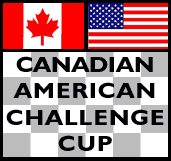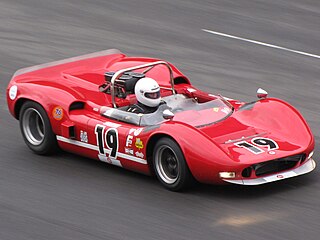Related Research Articles

The Ford GT40 is a high-performance endurance racing car commissioned by the Ford Motor Company. It grew out of the "Ford GT" project, an effort to compete in European long-distance sports car races, against Ferrari, which won the prestigious 24 Hours of Le Mans race from 1960 to 1965. Ford succeeded with the GT40, winning the 1966 through 1969 races.

Daniel Sexton Gurney was an American racing driver, race car constructor, and team owner who reached racing's highest levels starting in 1958. Gurney won races in the Formula One, Indy Car, NASCAR, Can-Am, and Trans-Am Series. Gurney is the first of three drivers to have won races in sports cars (1958), Formula One (1962), NASCAR (1963), and Indy cars (1967), the other two being Mario Andretti and Juan Pablo Montoya.

The Ford GT is a mid-engine two-seater sports car manufactured and marketed by American automobile manufacturer Ford for the 2005 model year in conjunction with the company's 2003 centenary. The second generation Ford GT became available for the 2017 model year.

The Porsche 917 is a sports prototype race car developed by German manufacturer Porsche. The 917 gave Porsche its first overall wins at the 24 Hours of Le Mans in 1970 and 1971. Powered by the Type 912 flat-12 engine of 4.5, 4.9, or 5 liters, the 917/30 Can-Am variant was capable of 0-62 mph (100 km/h) time of 2.3 seconds and 0–124 mph (200 km/h) in 5.3 seconds. The long tail Langheck version had a maximum measured top speed of 386 km/h (240 mph).

Riverside International Raceway was a motorsports race track and road course established in the Edgemont area of Riverside County, California, just east of the city limits of Riverside and 50 mi (80 km) east of Los Angeles, in 1957. In 1984, the raceway became part of the newly incorporated city of Moreno Valley. Riverside was noted for its hot, dusty environment and for being a somewhat complicated and dangerous track for drivers. It was also considered one of the finest tracks in the United States. The track was in operation from September 22, 1957, to July 2, 1989, with the last race, The Budweiser 400, won by Rusty Wallace, held in 1988. After that final race, a shortened version of the circuit was kept open for car clubs and special events until 1989.

The Canadian-American Challenge Cup, or Can-Am, was an SCCA/CASC sports car racing series from 1966 to 1987.
Chaparral Cars was a pioneering American automobile racing team and race car developer that engineered, built, and raced cars from 1963 through 1970. Founded in 1962 by American Formula One racers Hap Sharp and Jim Hall, it was named after the roadrunner, a fast-running ground cuckoo also known as a chaparral bird.

Kenneth Henry Miles was a British sports car racing engineer and driver best known for his motorsport career in the US and with American teams on the international scene. He is an inductee to the Motorsports Hall of Fame of America.

The Howmet TX was an American sports prototype racing car designed in 1968 to test the competitive use of a gas turbine engine in sports car racing. Planned by racing driver Ray Heppenstall, the TX combined a chassis built by McKee Engineering, turbine engines leased from Continental Aviation & Engineering, and financial backing and materials from the Howmet Corporation.

The McLaren M6A was a Group 7 prototype race car deisnged and developed by driver Bruce McLaren, and built by his Bruce McLaren Motor Racing team for their entry in 1967 Can-Am season. As a replacement for the team's M1Bs from 1966, the Chevrolet-powered M6A's improved design earned Bruce McLaren and his team their first of multiple Can-Am championships. After the M6As were replaced by the M8A in preparation for 1968, McLaren and technical partner Trojan–Tauranac Racing developed the M6B which was sold to customers for use in Can-Am as well as other racing series.
The Sportscar Vintage Racing Association (SVRA) is an American automobile club and sanctioning body that supports vintage racing in the United States. The organization was founded in 1981, and is regarded as the premier vintage racing organization in the U.S.
The Ford G7 is a Can-Am sports racing car that was built by Ford in 1968. Initially fitted with a 427 cu in (6,997 cc) Ford V8 engine, and later using 429 cu in (7,030 cc) and 496 cu in (8,128 cc) versions of the engine, the G7 was extremely unreliable and only ever finished one of the 15 races it competed in. In particular, it had serious issues with overheating and engine problems; the latter of which often prevented the car from even starting a race.

The McLaren M8A was a race car developed by driver Bruce McLaren and his Bruce McLaren Motor Racing team for their entry in 1968 Can-Am season. The M8A and its successors dominated Can-Am racing for four consecutive Can-Am seasons, until the arrival of the Porsche 917.
Gerald Jon 'Jerry' Hansen is a former racing driver. Hansen has won a record of 27 SCCA National Championships. Hansen has also competed in Can-Am, the Atlantic Championship, USAC ChampCar among other series.
The AVS Shadow, also known as the Shadow Mk.I, is a purpose-built sports prototype race car, designed, developed and built built by Shadow Racing Cars to Group 7 racing specifications, specifically to compete in the Can-Am racing series, in 1970. It was Shadow's first Can-Am car. Powered by a naturally aspirated, Chevrolet big-block engine, developing 740 hp (550 kW), and 655 lb⋅ft (888 N⋅m) of torque.

The Ferrari 712P is a purpose-built Group 7 prototype, designed, developed and built by Scuderia Ferrari specifically designed to compete Can-Am sports car races from 1970 to 1974. The 7 refers to the displacement of the engine in liters, the 12 refers to the number of cylinders, and the P stands for Prototype.

The McLaren M1A, and its derivatives, the McLaren M1B and the McLaren M1C, are a series of mid-engined Group 7 sports prototype race cars built by McLaren, between 1963 and 1968. The M1A was the team's first self-designed and developed sports car. Later versions, such as the 'M1B' and 'M1C', competed and raced in the North American Can-Am series, starting in 1966 season. The car was raced in North America and Europe in 1963 and 1964 in various Group 7 and United States Road Racing Championship series events. 24 examples of the M1A and M1B were built, and 25 examples of the M1C were manufactured. They were powered by a few different motors, including Chevrolet small-block engine, an Oldsmobile V8 engine, a Chevrolet big-block engine, and even a Ford FE engine. It was constructed out of a tubular space frame chassis, and, combined with its light weight of 551 kg (1,215 lb) this gave it a great power-to-weight ratio. The 4.5 L (270 cu in) Oldsmobile V8 engine developed around 310 hp (230 kW), while the 350 cu in (5.7 L) Chevrolet small-block V8 engine was capable of developing over 550 hp (410 kW), and 538 lb⋅ft (729 N⋅m) of torque. This drove the rear wheels through a Hewland L.G.400 four-speed manual transmission.
The McKee Mk.7, also designated as the McKee Mk.VII, is a special purpose-built American sports prototype race car, designed and developed by Bob Nagel, and built to Group 7 specifications, for the Can-Am series, in 1967. It won a total of 2 races, and achieved 4 podium finishes. The configuration is a mid-engine, rear-wheel-drive layout. The chassis is constructed out of a tubular space frame, wrapped in a fiberglass body. The powerplant that was used varied, but included a Chevrolet small-block, a Chevrolet big-block, an Oldsmobile V8, and even a Ford FE big-block engine.
The McKee Mk.10, also designated as the McKee Mk.X, is a special purpose-built American sports prototype race car, designed, developed, and built to Group 7 specifications, and competed in the Can-Am series, between 1968 and 1970. It was powered by both an Oldsmobile V8, and a Chevrolet small-block engine.
The McKee Mk.6 is a special purpose-built American sports prototype race car, designed, developed, and built by Bob McKee, in 1966. It competed in both the United States Road Racing Championship, and the Can-Am series. It achieved a total of 2 wins and 5 podium finishes. Career highlights for it include wins at both Road America and Riverside in 1966, a fourth-place finish at Las Vegas in 1966, and another podium finish at Watkins Glen that same year. It was powered by numerous engines, including Chevrolet, Ford, and Oldsmobile motors.
References
- ↑ "1969 McKee MK14 Armco CroSal technical and mechanical specifications". conceptcarz.com.
- ↑ "McKee Mk.14" . Retrieved 21 June 2022.
- ↑ "McKee Mk.14" . Retrieved 21 June 2022.
- ↑ "Just A Car Guy: Joe Leonard driving the McKee Mk. 14, a four-wheel drive special with an automatic transmission and a twin-turbo 7.5-liter Oldsmobile". January 2, 2017.
- ↑ "McKee « F5000 « OldRacingCars.com". www.oldracingcars.com.
- ↑ Brinker, Harold Pace Mark R. Vintage American Road Racing Cars 1950-1969. MotorBooks International. ISBN 9781610592406 – via Google Books.